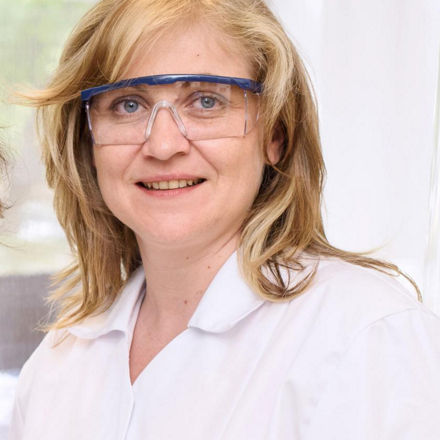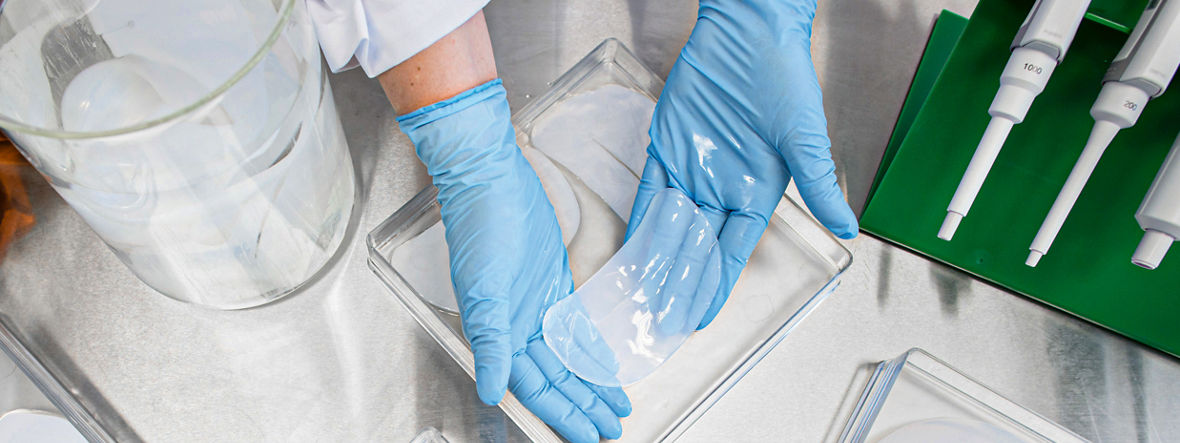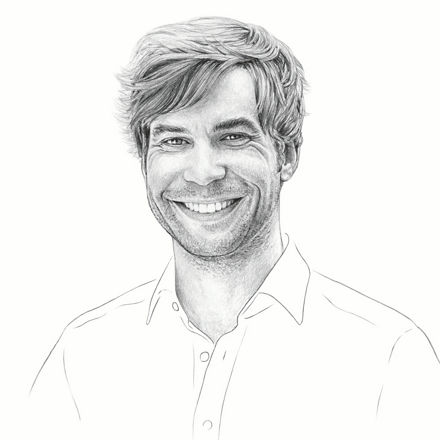Everything in Uwe Beekmann’s daily work has to do with a soft and relatively slippery membrane. This gelatinous substance is produced by bacteria in a fermentation process. Beekmann, who has a doctorate in pharmacology, is creating the conditions in which the microbes feel at home as they work. To feed the bacteria, Beekmann pours a glucose solution into a square glass dish. “The bacteria initially use the nutrient solution to survive and multiply,” says Beekmann, who works at the research and development department of the biotech company JeNaCell in Jena, Germany. “They then combine glucose components into fine fibers in order to protect themselves against dehydration and environmental factors such as ultraviolet radiation.” These spider silk-like objects of nanostructured cellulose eventually form a thin fleece that Beekmann carefully separates from the nutrient solution. It is afterwards cleaned so that all bacteria are removed and only the cellulose and water remain. The material can then be cut into any shape desired.

»To find out that our product really helps patients to heal faster was the best news we could get«
Dana Kralisch co-founder of JeNaCell
BACTERIA BEAT PLANTS
However, more important than the exterior shape is the material’s interior composition. “What’s special about the bioengineered cellulose is its close-knit internal web structure,” explains Beekmann. It gives the material its great stability and strength. “Added to that are its biocompatibility and good skin tolerance, which make it ideal for use in medical applications and cosmetics.” If the material were plant-based, it would not be possible to achieve these properties in this quality. That’s why the company is focusing on very productive strains of bacteria.
It all began with a few small Petri dishes full of cellulose that Dana Kralisch discovered in a lab at the Institute for Organic and Macromolecular Chemistry at the Friedrich Schiller University Jena in 2006.

Although no concrete application was foreseeable at the time, the material fascinated Kralisch, who had just received a Ph.D. in chemistry, so much that she initiated a research project. In addition to conducting work in the laboratory, she and her team began to look for markets. “We spent months surveying companies from a variety of sectors and investigated the possibility of collaboration,” she recalls.
It quickly became clear that the bioengineered cellulose promised to especially benefit the wound healing process. “It completely covers all open nerve ends and continuously cools and moistens the wound,” says Kralisch. The dressing particularly reduces the pain of burns because the material doesn’t stick to the wound and can therefore be easily changed.

»The technology has to be innovative and attractive for relevant markets«
Bernhard Mohr Head of Evonik's venture capital division
DISCOVERY AND EQUITY INVESTMENT
In 2012 the startup was spun off under the name JeNaCell and its activities really took off. “Although there were already many studies about this topic back then, there wasn’t an industrial manufacturing process,” relates Kralisch. “We therefore had to develop a biotechnological process that enables the material to be produced in large amounts.” The first production facility was soon put into operation so that the material could be supplied to the manufacturers of medical products. Kralisch vividly recalls the moment when she received the first report from a hospital that the biotech cellulose had been successfully employed. “To find out that our product really helps patients to heal faster was the best news we could get,” she says.
At this time, the company was also being monitored by Bernhard Mohr. As the head of Evonik’s venture capital unit, Mohr is always on the lookout for innovative startups. The decision in which companies Evonik invests is made according to clearly specified criteria: “The technology has to be innovative and attractive for relevant markets,” says Mohr. “Our confidence in the company’s management team also plays an important role.” JeNaCell fulfilled all of these criteria from the very start. “Because Evonik also has developed extensive expertise in fermentation, it was quickly clear that the startup would fit very well into our portfolio.”

»JeNaCell has evolved into
a technology platform«
Andreas Karau HEAD OF MEDICAL DEVICE SOLUTIONS
In 2015 Mohr and his team decided to invest in JeNaCell in order to enable a research and growth offensive. The startup intensified its cooperation with Evonik until it was acquired by the latter in the summer of 2021. Since then, the company has been part of the Health Care business line. “JeNaCell has increasingly evolved from purely a manufacturer of wound dressings into a technology platform,” says Dr. Andreas Karau, the head of Medical Device Solutions. The cellulose is now also being used for the dermatological post-treatment of cosmetic surgery and laser treatments. Moreover, the researchers are working on using bacterial nanocellulose in implants.

The material might even carry medication. “It would enable pharmaceutical active ingredients to be transported via the skin precisely to their destination in the body,” says Karau. And all of that is thanks to millions upon millions of bacteria in square glass dishes.
ELEMENTS-Newsletter
Get exciting insights into Evonik's research and its social relevance – conveniently delivered to your inbox.


